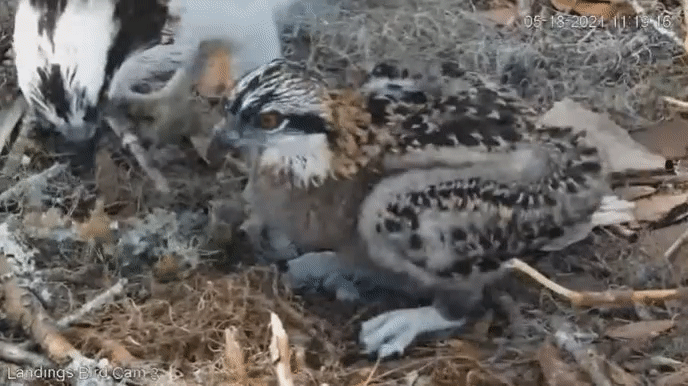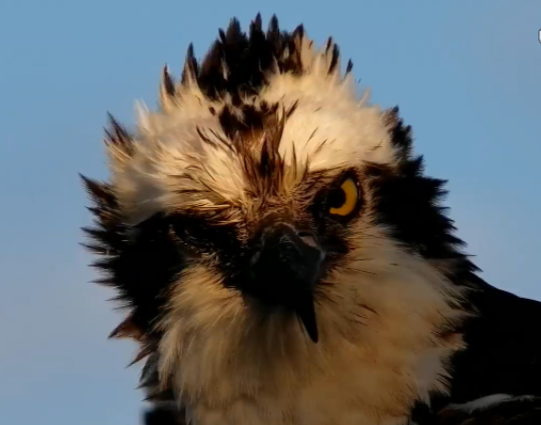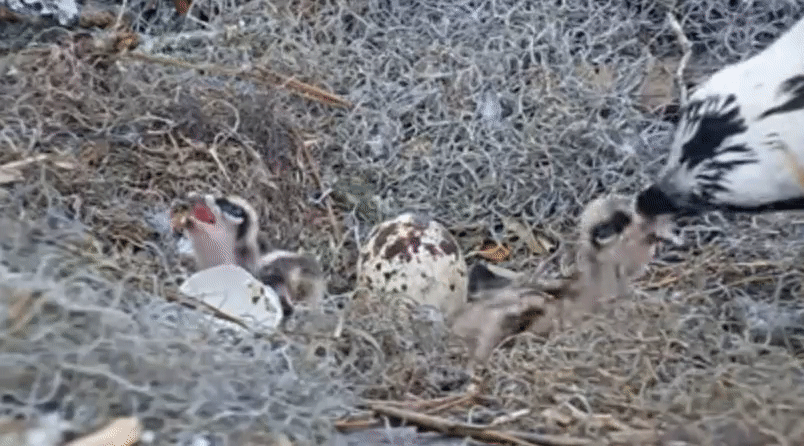Savanna Ospreys located at The Landings, on Skidaway Island, near Savannah, Georgia Home of 2 little ones and parents. "They live on a beautiful golf course"! Little chatterbox today... Siblings
Siblings  Dad sporting the Guy Fieri hair
Dad sporting the Guy Fieri hair April 13 & 16 hatch. This photo is from April 16th
April 13 & 16 hatch. This photo is from April 16th
 Youngest Osprey Chick Stumbles Around Nest, Shows Off Huge Crop – May 18, 2021https://youtu.be/zyg8EFi0rR4
Youngest Osprey Chick Stumbles Around Nest, Shows Off Huge Crop – May 18, 2021https://youtu.be/zyg8EFi0rR4 via cornell lab bird cams
The youngest Osprey chick goes on the move in the Savannah nest. Watch the nestling totter its way across the nest before resting to arrange some sticks and show off its bulging crop. Somebody's not going hungry today!Watch live at
www.allaboutbirds.org/savannahospreysDuring the Fall of 2014, a pair of Great Horned Owls began frequenting an abandoned Bald Eagle nest adjacent to a protected, nutrient-rich salt marsh along the Georgia coast. This nest sat nearly 80′ above one of the six Audubon International Certified golf courses at The Landings, on Skidaway Island, near Savannah, Georgia. Over the course of 2015 and 2016, a pair of owls successfully fledged four owlets from the site, but they did not return to breed in 2017.
Instead, a pair of Ospreys began renovating the nest and committed to breeding at the same site from 2017 to 2019, when the dead tree that held the nest was removed due to being designated as a falling hazard. A new nest site was erected in an adjacent tree in the fall of 2019, and the Ospreys were quick to take up residence at the new site in 2020.
Ospreys are consummate fishing birds, and this pair fishes primarily from the nearby salt marsh, ponds, and waterways. They use their 6–7 foot wingspans to soar above the water, looking for fish, then diving as deep as 3 feet for shallow-swimming prey. Adult Ospreys usually weigh 3–4 pounds, and they can carry prey up to 50 percent of their own weight. Ospreys can live up to 25 years, and they typically lay 1–4 eggs in a clutch.
Most Osprey pairs are monogamous, staying paired across seasons and beginning nesting soon after each returns from a long migration. Both sexes incubate the eggs. The female sits for the majority of the time (including throughout the night) while the male provisions her with fish. After the eggs hatch, the male continues to bring fish to the nest; the female exclusively broods the young and dissects their meals for about a month after hatching. Later on, when the chicks no longer require her protection and their appetite for fish increases, she will leave the nest and go fishing.

 Author
Topic: OSPREY * Savannah Ga and Hog Island 2020 2021 (Read 41704 times)
Author
Topic: OSPREY * Savannah Ga and Hog Island 2020 2021 (Read 41704 times)
